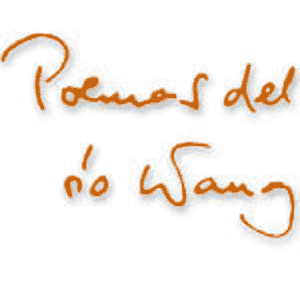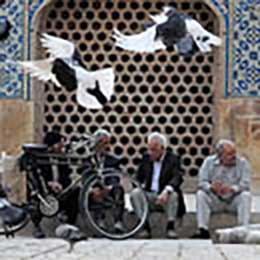 A. L. Gruenberg-Cvetinovic A. L. Gruenberg-Cvetinovic(also known in Western transliteration as Aleksandr Grjunberg) |
At 22, he graduated from Leningrad University with a degree in Iranian Linguistics. In 1953, Gruenberg started graduate studies in the Institute of Linguistics. His Ph.D. project studied the languages of the Tats of Northern Azerbaijan who lived in an array of semi-isolated foothill villages (unlike the then more numerous Mountain Jew Tats of Dagestan, some of the Azerbaijani Tats were Shia Muslims, and some Armenian Christians; one group, the famed Lahiji copper-smiths, still considered themselves to be Persian transplants, albeit from the legendary times of a Shahnameh king Kai Khosrow).
 Lahiji coppersmith at work, from a 2011 travelogue
Lahiji coppersmith at work, from a 2011 travelogueBut the most exotic adventure of the young grad student happened in 1958, in the mountains of Badakhshan, Tajikistan, in the Academy of Sciences Yeti expedition which quickly evolved into a hunt for languages and folklore of the Badakhshani highlanders. Although the Western world mostly got over the post-Everest Yeti craze by 1955-1956, Russia was, in its usual way, trailing a few years behind. Before his death in 1956, Vladimir Obruchev, a nonagenarian patriarch of Russian geology, drummed up some support for a hypothesis of Yeti in the mountains of Pamir, “the Roof of the World” as it was proudly known. Kirill Stanyukovich, a renowned geobotanist and scifi writer, reported that the locals told him about a “wild man” known to them as golub-yavan or possibly gul-bayavan. And in 1958, Stanyukovich was put in charge of the expedition which, as it happens, didn’t include any primatology researchers – but it did include iranologists.
 Lake Sarez, the supposed Golub-Yavan habitat according to Kirill Stanyukovich Lake Sarez, the supposed Golub-Yavan habitat according to Kirill Stanyukovich |
 The same Badakhshani mountain ranges and villages, from a 2012 travelogue
The same Badakhshani mountain ranges and villages, from a 2012 travelogue
The attention of Gruenberg thus turned to the isolated diasporas of the ethnic groups with homelands south of the Soviet border, which could have been studied within the confines of the Soviet Union. Between 1958 and 1960, he discovered and documented Teymuri, Jamshidi, and Sistani populations in Saraghs and Kushka, in the South of Turkmenistan. And then Gruenberg got a unique opportunity to study rare languages of Hindu Kush valleys right there, through a translator assignment with the Afghan Ministry of Mining Industry. Between 1963 and 1968, he conducted wide-ranging fieldwork in remote Nuristan, the legendary refuge of Alexander the Great’s troops, for the first time documenting such languages as Munjani, Glangali and Kati. (Alas, much of his field materials still awaited processing by the time of his sudden death in 1995; one dead-ended project has been a joint development, with the Afghanistan Academy of Sciences, of Dari-based alphabet systems for Balochi, Kafiristani, Pamiri, and Pashai languages).
 Saraghs-Baba Mausoleum, Turkmenistan, 1024 Saraghs-Baba Mausoleum, Turkmenistan, 1024 |
Ostensibly a dry academic study, the book of Tales and Legends of Sistan has been so wonderfully poetic inside, that it reached 75,000 print copies, and won wide fandom. Aleksandr Gruenberg ended up co-authoring numerous other translations of Central Asian folk legends and tales, often expressly to translate their poetic vignettes. He co-translated books of Tat, Turkish, and Pamiri legends, and Iranian “anonymous tales”, with hundreds of wonderfully interpreted verses. My Eglish re-translation may not do them justice, but still, for a little taste of Gruenberg’s word, here is a canonic preface used for Shahnameh chapters as well as for all other Sistani epic histories:
| Голос донесся с бескрайних небес, с синего купола дальних небес: «Мудрый рассказчик, дервиш-острослов не надевает на слово оков; страстным влюбленным, тоской обуянным, мчится оно фарсанг за фарсангом, ловко, как заяц, и сладко, как мед...». Шайтан приказал нам посеять табак, куришь — погибнешь, погибнешь и так! Курит Аббас, что в Иране царем, пусть себе курит, да дело не в нем... Слова — это шерсть, я же войлок валяю; слова — молоко, я же масло сбиваю. Ложь безграничная — вот мой рассказ. Верблюд на блохе едет в город Шираз. Ива и тополь, сосна и чинар сладких плодов не приносят нам в дар; гранат и айва, померанец и тут сочные щедро плоды нам дают. Хлебом пусть станет вершина Ходжа, в мясную шурпу Хильменд превратится. Явился старик, чтоб шурпой подкрепиться. «Много не съесть мне,— старик говорит.— Стар я, устал я, и почка болит. Съел я три сотни бараньих голов, ножек без счета — а все же не сыт!» | A voice has been heard from the boundless sky, From the blue dome of heavenly sky: “Wise storyteller, sharp-tongued dervish Set your word free, may it fly as you wish. Racing ahead like a yearning lover, Parasangs of distance at once may it cover, Swift like a hare and fluid like honey! Devil gave us tobacco and showed the way. Smoke will kill you; you’ll die anyway. Abbas the Shah has been smoking too; Just let him be, for this tale is for you. Words are like wool, I’m making some felts; Words are like milk, I’m beating some butter. My story is made of impossible lies, A camel rides a flea to the city of Shiraz. Poplar and willow, cypress and pine Won’t bear fruit for us to dine; Pomegranate and quince and mulberry trees With their sweet fruits everyone please. May Mountain Hojja be a mound of bread, May River Helmand be shurpa, rich of lamb! An old man rode in for the nourishing soup. I can’t eat much, so says the old man I’m tired and frail, and my gut hurts again I ate whole piles of boiled lamb legs, Three hundred lamb heads, And I still want some more.” |
Over the past years, the Hozeye Honari Musical Center in Tehran published in thirty-two CDs a comprehensive compilation of the living Shahnameh and epic tradition from the various provinces of Iran. We only have six from the thirty-two, and the Sistani CD is not among them. Let us listen instead to this local version of the Shahnameh from a Lorestani (Western Iran, Zagros Mountains) story-teller.


























































































Add comment